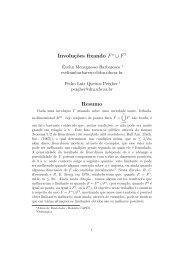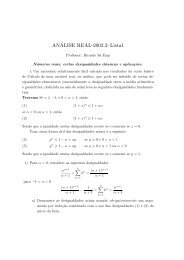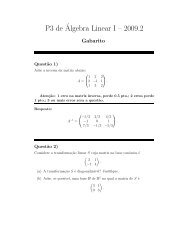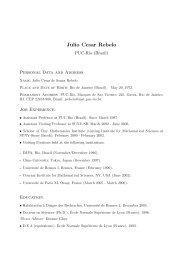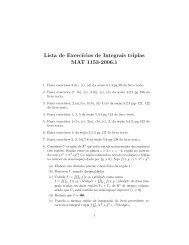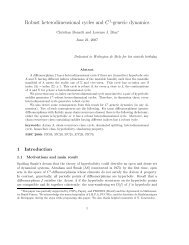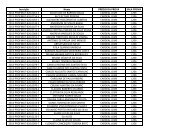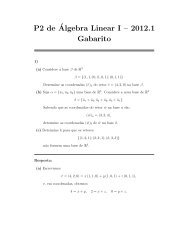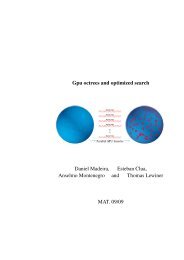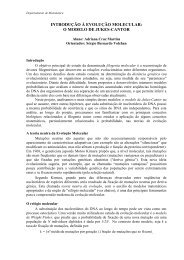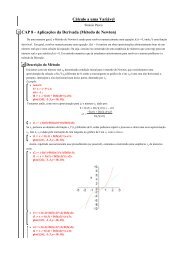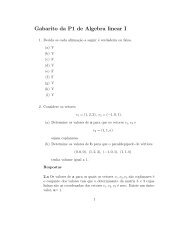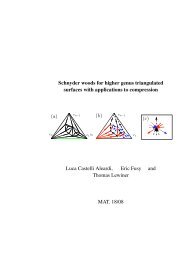(1) Fazer os seguintes exercıcios d - Departamento de Matemática ...
(1) Fazer os seguintes exercıcios d - Departamento de Matemática ...
(1) Fazer os seguintes exercıcios d - Departamento de Matemática ...
Create successful ePaper yourself
Turn your PDF publications into a flip-book with our unique Google optimized e-Paper software.
LISTA DE EXERCÍCIOS DE GEOMETRIA NO PLANO<br />
E NO ESPAÇO E INTEGRAIS DUPLAS<br />
MAT 1153-2006.2<br />
(1) <strong>Fazer</strong> <strong>os</strong> <strong>seguintes</strong> exercíci<strong>os</strong> do livro texto. Exercs da seção<br />
1.1.4: 1(d), 1(f), 1(h), 1(i), 1(j). 2(b), 2(d)<br />
(2) <strong>Fazer</strong> <strong>os</strong> <strong>seguintes</strong> exercíci<strong>os</strong> do livro texto. Exercs da seção<br />
1.2.5: 2(f), 4(c), 4(d). 5(a), 5(b), 5(e).<br />
(3) <strong>Fazer</strong> <strong>os</strong> <strong>seguintes</strong> exercíci<strong>os</strong> do livro texto. Exercs da seção<br />
2.1.4: Exercs 1(b), 4(a), 4(b).<br />
(4) Consi<strong>de</strong>re as superfícies dadas abaixo. Determine: Interseção<br />
com <strong>os</strong> plan<strong>os</strong> coor<strong>de</strong>nad<strong>os</strong>, xy, xz, yz. Estu<strong>de</strong> as interseções<br />
com <strong>os</strong> plan<strong>os</strong> z = c, c ∈ R, quando tais interseções forem<br />
círcul<strong>os</strong>. I<strong>de</strong>ntifique as superfícies <strong>de</strong> revolução (e seus eix<strong>os</strong>).<br />
Explicite também <strong>os</strong> plan<strong>os</strong> <strong>de</strong> simetria π das superfícies: Isto<br />
é, reflexão em π, <strong>de</strong>ixa a superfície invariante, levando uma<br />
”meta<strong>de</strong>” <strong>de</strong>sta na outra ”meta<strong>de</strong>”. Lembrando <strong>de</strong> Cálculo II,<br />
escreva a equação do plano tangente ao gráfico quando pedido.<br />
Esboce um <strong>de</strong>senho <strong>de</strong> cada superfície com apuro.<br />
(a) x 2 + y 2 + z 2 = 1.<br />
(b) x 2 + y 2 /4 + z 2 /9 = 1.<br />
(c) x 2 +y 2 −z 2 = −1 (hiperbolói<strong>de</strong> com 2 folhas. Veja Figura 1 ).<br />
Escreva a equação do plano tangente ao hiperbolói<strong>de</strong> no<br />
ponto (2, 0, √ 5).<br />
(d) x 2 + z 2 − y 2 = −1.<br />
(e) x 2 +y 2 −z 2 = 1 (hiperbolói<strong>de</strong> com 1 folha. Veja Figura 2).<br />
(f) (x − 1) 2 + (y + 1) 2 − (z − 3) 2 = −1.<br />
(g) x 2 + y 2 + z 2 /4 = 1.<br />
(h) x 2 + y 2 = 9z 2 .<br />
(i) x 2 + z 2 = 9y 2 .<br />
(j) x 2 − y 2 = z.<br />
(k) y 2 = z Escreva a equação do plano tangente ao gráfico no<br />
ponto (1, 1, 1).<br />
(l) z = xy (Sela. Veja Figura 3). Escreva a equação do plano<br />
tangente ao gráfico no ponto (1, 1, 1).<br />
1
2 LISTA1 DE MAT1153<br />
(m) c<strong>os</strong>h z = √ x 2 + y 2 (catenói<strong>de</strong>. Veja Figura 4). Escreva a<br />
equação do plano tangente ao gráfico no ponto (1, 1, arcc<strong>os</strong>h( √ 2)).<br />
Lembrete: c<strong>os</strong>h z = ez + e −z<br />
.<br />
2<br />
2<br />
(n) z = √ . Procure encontrar um cilindro para o<br />
1 − x2 − y2 qual a superfície “converge” quando z → ∞. Veja Figura 5.<br />
( c<strong>os</strong> y<br />
)<br />
(o) z = log , −π/2 < x < π/2 − π/2 < y < π/2.<br />
c<strong>os</strong> x<br />
(Superfície <strong>de</strong> Scherk. Veja Figura 6).<br />
Figura 1: Hiperbolói<strong>de</strong> com 2 folhas
LISTA1 DE MAT1153 3<br />
Figura 2: Hiperbolói<strong>de</strong> com 1 folha<br />
Figura 3: Sela
4 LISTA1 DE MAT1153<br />
Figura 4: Catenói<strong>de</strong><br />
Figura 5
LISTA1 DE MAT1153 5<br />
Figura 6: Superfície <strong>de</strong> Scherk<br />
(5) Consi<strong>de</strong>re a regiões do plano R 1 = {(x, y) ∈ R 2 ; 1 y x 2 +<br />
1, 0 x 1} e R 2 = {(x, y) ∈ R 2 ; 1 y −x/3 + 7/3, 1 <br />
x 4}. Seja R := R 1 ∪ R 2 . ∫∫<br />
Consi<strong>de</strong>re a integral dupla: I = F (x, y) dxdy<br />
(a) Esboce um <strong>de</strong>senho <strong>de</strong> R. Escreva, sem fazer cálcul<strong>os</strong>, uma<br />
soma <strong>de</strong> duas integrais iteradas, usando integrais do tipo<br />
∫ b ∫ f2 (x)<br />
a<br />
f 1 (x)<br />
F (x, y) dydx, que seja igual a I.<br />
(b) Escreva, sem fazer cálcul<strong>os</strong>, uma integral iterada, usando<br />
integrais do tipo<br />
∫ d ∫ g2 (y)<br />
c<br />
g 1 (y)<br />
R<br />
F (x, y) dxdy, que seja igual a<br />
I.<br />
(c) Calcule a área <strong>de</strong> R e calcule a coor<strong>de</strong>nada y do centrói<strong>de</strong><br />
<strong>de</strong> R. Resp<strong>os</strong>ta: A = área(R) = 11<br />
6 , y = 73/55.
6 LISTA1 DE MAT1153<br />
(6) Consi<strong>de</strong>re as superfícies D, D 1 e S 1 <strong>de</strong>finidas a seguir (esboce<br />
um <strong>de</strong>senho) :<br />
D = {(x, y, z) ∈ R 3 ; x 2 + y 2 9, z = 0}<br />
D 1 = {(x, y, z) ∈ R 3 ; z = x + y + 7, x 2 + y 2 9}<br />
S 1 = {(x, y, z) ∈ R 3 ; 0 z x + y + 7, x 2 + y 2 = 9}<br />
Consi<strong>de</strong>re S := D ∪ S 1 ∪ D 1 a superfície fechada, que é fronteira<br />
<strong>de</strong> um sólido U ⊂ R 3 .<br />
(a) Desenhe corretamente S.<br />
(b) Escreva o volume <strong>de</strong> U usando coor<strong>de</strong>nadas retangulares.<br />
Escreva ∫∫ o volume <strong>de</strong> U [ usando coor<strong>de</strong>nadas polares.<br />
2<br />
(c) Calcule (x + y + 7)<br />
(x 2 + y 2 + 1) + 1 ]<br />
dxdy. Resp<strong>os</strong>ta:<br />
2 10<br />
D<br />
189π/10. Sugestão: Use coor<strong>de</strong>nadas polares<br />
(7) Consi<strong>de</strong>re a região R do plano xy cuja fronteira dada por R :=<br />
[1/2, 1] × [1, 3]. Calcule<br />
∫∫<br />
f(x, y)dxdy<br />
R<br />
on<strong>de</strong><br />
(a) f(x, y) = −x log x c<strong>os</strong>(πy)sen 2 (πy)<br />
(b) f(x, y) =<br />
2y x c<strong>os</strong>(πx)<br />
1+y 2<br />
(c) f(x, y) = √ 2x e −√ y<br />
√ 1−x 2 y<br />
(d) f(x, y) = 2xe x log y<br />
(e) f(x, y) = y3 +y 2 −y 1<br />
y+1 2x+10<br />
(f) f(x, y) = e y sen y x 4 e −7x5 .<br />
(g) f(x, y) = y √ y + 1 sen x c<strong>os</strong> 2 x.<br />
(Resp<strong>os</strong>tas (a): 0 (b): − log 5(1/(2π)+1/π 2 ) (c): 2 √ 3(e −1 −<br />
e −√3 ) (d): (3 log 3 − 2) √ e (e): (20/3 + log 2) log(12/11)/2)<br />
(8) Em cada sub-item do item anterior, interprete a integral dupla<br />
em term<strong>os</strong> <strong>de</strong> volume <strong>de</strong> uma região U do espaço, <strong>de</strong>terminando<br />
rigor<strong>os</strong>amente U usando inequações.<br />
(9) Consi<strong>de</strong>re as regiões U 1 , U 2 do espaço dadas por:<br />
U 1 ={(x, y, z) ∈ R 3 ; 0 z 9 − x 2 − y 2 , 0 x y}<br />
U 2 = {(x, y, z) ∈ R 3 ; 0 z 9 − (x − 1) 2 − (y − 3) 2 }<br />
(a) Escreva o volume V 1 da região U 1 usando integrais iteradas,<br />
via coor<strong>de</strong>nadas cartesianas ou retangulares usuais x, y.
LISTA1 DE MAT1153 7<br />
(b) Escreva o volume V 1 da região U 1 , usando coor<strong>de</strong>nadas polares<br />
e calcule V 1 .<br />
(c) Calcule o volume V 2 <strong>de</strong> U 2 . Resp<strong>os</strong>ta: V 1 = 81π/16, V 2 =<br />
81π/2. Sugestão: use <strong>os</strong> itens prece<strong>de</strong>ntes.<br />
(10) Consi<strong>de</strong>re a região U do espaço dada por U := {(x, y, z) ∈<br />
R 3 ; 0 z y 2 + x; 0 y sen x, 0 x π}.<br />
(a) Escreva o volume <strong>de</strong> U usando uma integral iterada nas<br />
variáveis x, y.<br />
(b) Calcule o volume <strong>de</strong> U. Resp<strong>os</strong>ta: volume(U) = 4/9 + π.<br />
(c) Seja W := {(x, y, z) ∈ R 3 ; 0 z y 2 + x; −sen x y <br />
sen x, 0 x π}. Calcule o volume <strong>de</strong> W. Sug: Faça o<br />
mínimo <strong>de</strong> contas p<strong>os</strong>sível, justificando corretamente a sua<br />
resp<strong>os</strong>ta.<br />
(11) Consi<strong>de</strong>re a região R = {(x, y) ∈ R 2 ; x 2 + y 2 √ 2}. Seja A<br />
o∫∫<br />
número real p<strong>os</strong>itivo <strong>de</strong>terminado pela integral dupla : A =<br />
[<br />
4 − (x 2 + y 2 ) 4] dxdy. Calcule as <strong>seguintes</strong> integrais duplas<br />
R<br />
em termo <strong>de</strong> A. Não é preciso calcular A, mas é preciso dar uma<br />
justificativa matemática correta.<br />
(a) Usando <strong>de</strong>sigualda<strong>de</strong>s, <strong>de</strong>termine U ⊂ R 3 tal que A =<br />
volume(U). ∫∫<br />
Calcule I 1 = 4 − ( (x − 1) 2 + (y + 1) 2) ] 4<br />
dxdy, on<strong>de</strong>,<br />
R 1<br />
[<br />
R 1 = {(x, y) ∈ R 2 ; (x − 1) 2 + (y + 1) 2 √ 2}. Justifique<br />
sua resp<strong>os</strong>ta. ∫∫<br />
[<br />
(b) I 2 = 4 − (x 2 + y 2 ) 4] dxdy, on<strong>de</strong> R 2 = {(x, y) ∈ R 2 ; x 2 +<br />
R 2<br />
y 2 √ ∫∫2, 0 x y}. Justifique sua resp<strong>os</strong>ta.<br />
[<br />
(c) I 3 = 7 − (x 2 + y 2 ) 4] dxdy. Justifique sua resp<strong>os</strong>ta.<br />
R<br />
(12) Determine o volume do sólido <strong>de</strong>limitado pel<strong>os</strong> parabolói<strong>de</strong>s<br />
z = 4x 2 + 2y 2 e z = 12 + x 2 − y 2 . I<strong>de</strong>m com respeito a<strong>os</strong><br />
parabolói<strong>de</strong>s z = x 2 + 3y 2 e z = 4 − y 2 (Resp<strong>os</strong>tas: 24π e 4π).<br />
∫ 4<br />
√<br />
16−x 2<br />
∫ √<br />
(13) Seja V := 8<br />
16 − x2 dydx. Interprete V como sendo<br />
x=0<br />
y=0<br />
o volume <strong>de</strong> uma certa região do espaço <strong>de</strong>limitada por dois<br />
cilindr<strong>os</strong>. Calcule V (Resp<strong>os</strong>ta: 1024/3). Veja Figura 7.
8 LISTA1 DE MAT1153<br />
Figura 7<br />
(14) Consi<strong>de</strong>re a região R do plano <strong>de</strong>limitada pelas parábolas y =<br />
x 2 + 1 e y = −x 2 + 9.<br />
(a) Calcule a área <strong>de</strong> R (Resp<strong>os</strong>ta: 64/3).<br />
(b) Calcule o centrói<strong>de</strong> <strong>de</strong> R (Resp<strong>os</strong>ta: 5).<br />
(c) Calcule o valor médio da função f(x, y) = x 2 em R (Resp<strong>os</strong>ta:<br />
12/5).<br />
(15) Consi<strong>de</strong>re as regiões R 1 , R 2 do plano dadas por:<br />
R 1 ={(x, y) ∈ R 2 ; 0 x y 1}<br />
R 2 = {(x, y) ∈ R 2 ; 1 − x 2 y 2 }<br />
Seja R := R 1 ∩ R 2 .<br />
∫∫<br />
Consi<strong>de</strong>re a integral dupla I :=<br />
R<br />
y<br />
x 2 + y 2 dxdy.<br />
(a) Faça o <strong>de</strong>senho da região R. Escreva, usando coor<strong>de</strong>nadas<br />
retangulares x, y, sem fazer cálcul<strong>os</strong>, uma integral iterada,<br />
que seja igual a I.<br />
(b) Escreva sem fazer cálcul<strong>os</strong>, usando coor<strong>de</strong>nadas polares uma<br />
fórmula, que seja igual a I.<br />
(c) Calcule I. Resp<strong>os</strong>ta: π/4 − √ 2/2.<br />
(16) Seja R := {(x, y) ∈ R 2 ; 0 x y, x 2 + (y − 1) 2 1}.
LISTA1 DE MAT1153 9<br />
(a) Determine R usando coor<strong>de</strong>nadas polares. Sug: esboce um<br />
<strong>de</strong>senho.<br />
∫∫<br />
(b) Escreva a integral dupla I = 4(x 2 + y 2 ) dxdy, usando<br />
coor<strong>de</strong>nadas polares.<br />
(c) Usando que<br />
∫ π/2<br />
π/4<br />
R<br />
sen 4 θdθ = 3π/32 + 1/4, <strong>de</strong>duza que I =<br />
3π/2 + 4<br />
(17) Consi<strong>de</strong>re U a região sólida interior à esfera dada por x 2 + y 2 +<br />
z 2 = 16, que está também no interior do cilindro dado por<br />
x 2 + (y − 2) 2 = 4.<br />
(a) Determine U usando <strong>de</strong>sigualda<strong>de</strong>s e faça um <strong>de</strong>senho da<br />
região.<br />
(b) Calcule o volume <strong>de</strong> U (Resp<strong>os</strong>ta: 128π/3 + 512/9).<br />
(18) Consi<strong>de</strong>re a região A <strong>de</strong>limitada pelo cardiói<strong>de</strong> dado em coor<strong>de</strong>nadas<br />
polares por r = 2 + c<strong>os</strong> θ. Calcule a área da região<br />
R obtida removendo-se <strong>de</strong> A o disco <strong>de</strong> raio 1/2 centrado na<br />
origem. (Resp<strong>os</strong>ta: 4π + π/4). Veja Figura 8.<br />
Figura 8<br />
(19) Consi<strong>de</strong>re a região A <strong>de</strong>limitada pelo cardiói<strong>de</strong> dado em coor<strong>de</strong>nadas<br />
polares por r = 1 + c<strong>os</strong> θ. Calcule a área da região R
10 LISTA1 DE MAT1153<br />
obtida removendo-se <strong>de</strong> A, a parte que está contida em A do<br />
disco <strong>de</strong> raio 1/2 centrado na origem .<br />
(20) Calcule I <strong>de</strong>terminando as regiões <strong>de</strong> integração e interpretando<br />
o resultado<br />
∫ 2 ∫ 2<br />
∫∫<br />
x<br />
I = √<br />
x2 + y dydx + √<br />
1 − x2 − y 2 /4 dxdy<br />
2<br />
x=0 y=x<br />
on<strong>de</strong> R é a região do plano dada por x 2 +y 2 /4 1 (Resp<strong>os</strong>ta:<br />
2 √ 2 − 2 + 2π/3).<br />
(21) Seja R := {(x, y) ∈ R 2 ; x 2 /4 + y 2 /9 1}. Calcule o volume da<br />
região U <strong>de</strong> R 3 <strong>de</strong>limitada pelo gráfico da funções z = x 2 +y 2 +1<br />
e z = 2xy restritas à região R (Resp<strong>os</strong>ta: 51π/2).<br />
R



